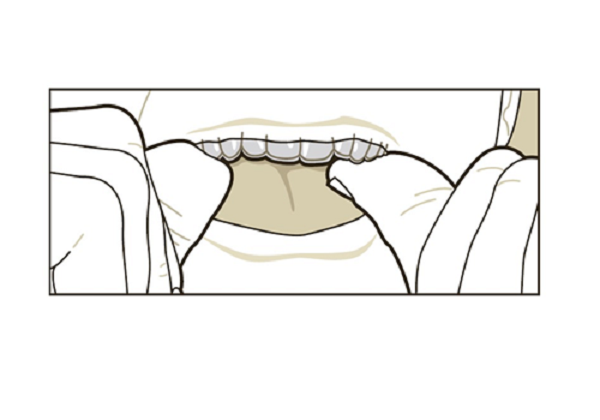Use And Care Instructions
USE AND CARE INSTRUCTIONS
For Your Invisalign® Aligners
Here are some tips to help ensure proper use and avoid damaging your aligners.
Always remember to:
- Wear your aligners per your doctor’s instructions, usually 20-22 hours per day.
- Wash your hands thoroughly with soap and water before handling your aligners.
- Handle only ONE aligner at a time.
- Rinse your aligners when removing them from the packaging.

Aligner Insertion
- Make sure you have the proper aligner—the upper for your top teeth and the lower for your bottom teeth.
- To help avoid confusion, each aligner is engraved with your unique case number, a “U” for upper and an “L” for lower, followed by the stage number.

- You may insert either the upper or lower aligner first. When inserting each aligner, gently push the aligners over your front teeth. Then apply equal pressure, using your fingertips, to the tops of your left and right molars (back teeth) until the aligner snaps into place.
- Do NOT bite your aligners into position. This may damage them.
Note: If you experience sharp pain or significant discomfort, discontinue use of the aligners, and contact your doctor.

Aligner Removal
- On one side of your mouth, use your fingertip on the inside of your back molar to slowly pull the aligner from your molars.
- Repeat this process on the other side of your mouth before trying to completely remove the aligner.
- Once aligner is disengaged from the molars on both sides of your mouth, you should be able to slowly work your way forward gently prying the aligner away from your teeth with your fingertips.
Note:
- Immediately rinse aligner with water, shake off excess water, and store your aligners in the protective case provided with your starter kit.
- To help prevent damage to the aligners, avoid unnecessary removal.
- Take care in removing your aligners, especially if multiple attachments are being used.
- Do not use excessive force to bend or twist an aligner to get it off.
- DO NOT use any sharp object to remove your aligners.
- Consult with your doctor if your aligners are extremely difficult to remove.

Daily Care And Maintenance Of Your Invisalign® Aligners
- Clean your aligners prior to each insertion. Use a soft bristle toothbrush with water and a small amount of toothpaste. You may find it easiest to clean the outside of your aligners by brushing them while they are still on your teeth, then remove your aligners to clean the inside surfaces.
Note: Be sure to rinse each aligner thoroughly with water after each cleaning. We also recommend that you use the Invisalign aligner cleaning products once a week, or as needed. - Do NOT use denture cleaners to clean aligners. Do NOT soak them in mouthwash. These products can damage the surface of the aligner, causing it to become dull and more visible.

Proper Oral Hygiene
- Remove your aligners for eating and drinking. (You do not need to remove your aligners to drink cool water.)
- Brush and floss your teeth after each meal or snack prior to reinserting your aligners. If you don’t have access to your cleaning system or a toothbrush, you can simply rinse your mouth, and then clean your aligners by holding them under warm running water. It’s not the best way to clean, but it works in a pinch. Be sure to thoroughly clean your aligners at your earliest convenience.
- If you have any questions regarding hygiene techniques, please consult your doctor.
- Regular dental active maintenance appointments and cleaning are recommended for the continued health of your teeth and gums.
Storing your Invisalign Aligners
One blue aligner case is included in your starter kit, and we recommend that you store your Invisalign aligners in a case when they are not in your mouth. This will help protect them from loss and damage.
Note: Keep all your older aligners in a clean plastic bag, or as instructed by your doctor. Keep them out of reach of small children and pets.
Frequently Asked Questions & Answers
Will the treatment be painful?
This soreness should gradually go away a couple of days after inserting the new aligner in the series. If it doesn’t, promptly call your doctor.
Will wearing the Invisalign aligners affect my speech?
However, as your tongue gets used to having aligners in your mouth, any lisp or minor speech impediment caused by your aligners should disappear.
What should I do if my new Invisalign aligner doesn’t snap onto my teeth?
In the event of significant problems with aligner fit, inform your doctor.
Are there restrictions on what I can eat?
Thus, there is no need to restrict your consumption of any of your favourite foods and snacks, unless otherwise instructed by your doctor.
Is it OK to drink hot or cold beverages while wearing Invisalign aligners?
Can I chew gum while wearing Invisalign aligners?
We recommend removing your aligners for all snacks and meals.
Will smoking or chewing tobacco stain the aligners?
Why do some of my aligners have bumps or ridges on them?
These bumps, or wells, are where the aligner grips the attachment the doctor places on your teeth. The attachments are small pieces of composite the doctor affixes to your teeth that are then gripped by bumps on your aligners.
The ridges are slim indentations in your aligners. Your doctor will use one or both of these features to attempt to achieve the desired movement.
What if I lose or break an Invisalign aligner?
He or she will possibly order you a new set of aligners to replace the ones you just lost, which should arrive in a few days.

NEED HELP?

BUSINESS HOURS
Fri 9:00 AM - 5:00 PM
Sat 9:00 AM – 1:00 PM

OUR ADDRESS
Launceston TAS 7250
